Bub1 kinase activity drives error correction and mitotic checkpoint control but not tumor suppression
- PMID: 23209306
- PMCID: PMC3518220
- DOI: 10.1083/jcb.201205115
Bub1 kinase activity drives error correction and mitotic checkpoint control but not tumor suppression
Abstract
The mitotic checkpoint protein Bub1 is essential for embryogenesis and survival of proliferating cells, and bidirectional deviations from its normal level of expression cause chromosome missegregation, aneuploidy, and cancer predisposition in mice. To provide insight into the physiological significance of this critical mitotic regulator at a modular level, we generated Bub1 mutant mice that lack kinase activity using a knockin gene-targeting approach that preserves normal protein abundance. In this paper, we uncover that Bub1 kinase activity integrates attachment error correction and mitotic checkpoint signaling by controlling the localization and activity of Aurora B kinase through phosphorylation of histone H2A at threonine 121. Strikingly, despite substantial chromosome segregation errors and aneuploidization, mice deficient for Bub1 kinase activity do not exhibit increased susceptibility to spontaneous or carcinogen-induced tumorigenesis. These findings provide a unique example of a modular mitotic activity orchestrating two distinct networks that safeguard against whole chromosome instability and reveal the differential importance of distinct aneuploidy-causing Bub1 defects in tumor suppression.
Figures

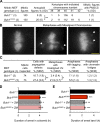
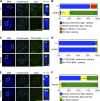


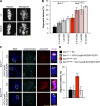
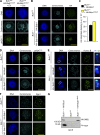
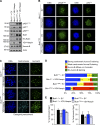


Similar articles
-
Aurora B hyperactivation by Bub1 overexpression promotes chromosome missegregation.Cell Cycle. 2011 Nov 1;10(21):3645-51. doi: 10.4161/cc.10.21.18156. Epub 2011 Nov 1. Cell Cycle. 2011. PMID: 22033440 Free PMC article. Review.
-
Bub1 overexpression induces aneuploidy and tumor formation through Aurora B kinase hyperactivation.J Cell Biol. 2011 Jun 13;193(6):1049-64. doi: 10.1083/jcb.201012035. Epub 2011 Jun 6. J Cell Biol. 2011. PMID: 21646403 Free PMC article.
-
Chromosome segregation regulation in human zygotes: altered mitotic histone phosphorylation dynamics underlying centromeric targeting of the chromosomal passenger complex.Hum Reprod. 2015 Oct;30(10):2275-91. doi: 10.1093/humrep/dev186. Epub 2015 Jul 29. Hum Reprod. 2015. PMID: 26223676
-
Bub1 mediates cell death in response to chromosome missegregation and acts to suppress spontaneous tumorigenesis.J Cell Biol. 2007 Oct 22;179(2):255-67. doi: 10.1083/jcb.200706015. Epub 2007 Oct 15. J Cell Biol. 2007. PMID: 17938250 Free PMC article.
-
Killing two birds with one stone: how budding yeast Mps1 controls chromosome segregation and spindle assembly checkpoint through phosphorylation of a single kinetochore protein.Curr Genet. 2020 Dec;66(6):1037-1044. doi: 10.1007/s00294-020-01091-x. Epub 2020 Jul 6. Curr Genet. 2020. PMID: 32632756 Review.
Cited by
-
High rates of chromosome missegregation suppress tumor progression but do not inhibit tumor initiation.Mol Biol Cell. 2016 Jul 1;27(13):1981-9. doi: 10.1091/mbc.E15-10-0747. Epub 2016 May 4. Mol Biol Cell. 2016. PMID: 27146113 Free PMC article.
-
Kinetochore-localized BUB-1/BUB-3 complex promotes anaphase onset in C. elegans.J Cell Biol. 2015 May 25;209(4):507-17. doi: 10.1083/jcb.201412035. Epub 2015 May 18. J Cell Biol. 2015. PMID: 25987605 Free PMC article.
-
Inhibitors of the Bub1 spindle assembly checkpoint kinase: synthesis of BAY-320 and comparison with 2OH-BNPP1.R Soc Open Sci. 2021 Dec 15;8(12):210854. doi: 10.1098/rsos.210854. eCollection 2021 Dec. R Soc Open Sci. 2021. PMID: 34925867 Free PMC article.
-
miR-186 induces tetraploidy in arsenic exposed human keratinocytes.Ecotoxicol Environ Saf. 2023 May;256:114823. doi: 10.1016/j.ecoenv.2023.114823. Epub 2023 Mar 27. Ecotoxicol Environ Saf. 2023. PMID: 36989553 Free PMC article.
-
Mosaic variegated aneuploidy in development, ageing and cancer.Nat Rev Genet. 2024 Dec;25(12):864-878. doi: 10.1038/s41576-024-00762-6. Epub 2024 Aug 21. Nat Rev Genet. 2024. PMID: 39169218 Review.
References
-
- Bolanos-Garcia V.M., Kiyomitsu T., D’Arcy S., Chirgadze D.Y., Grossmann J.G., Matak-Vinkovic D., Venkitaraman A.R., Yanagida M., Robinson C.V., Blundell T.L. 2009. The crystal structure of the N-terminal region of BUB1 provides insight into the mechanism of BUB1 recruitment to kinetochores. Structure. 17:105–116 10.1016/j.str.2008.10.015 - DOI - PMC - PubMed
Publication types
MeSH terms
Substances
Grants and funding
LinkOut - more resources
Full Text Sources
Other Literature Sources
Molecular Biology Databases

